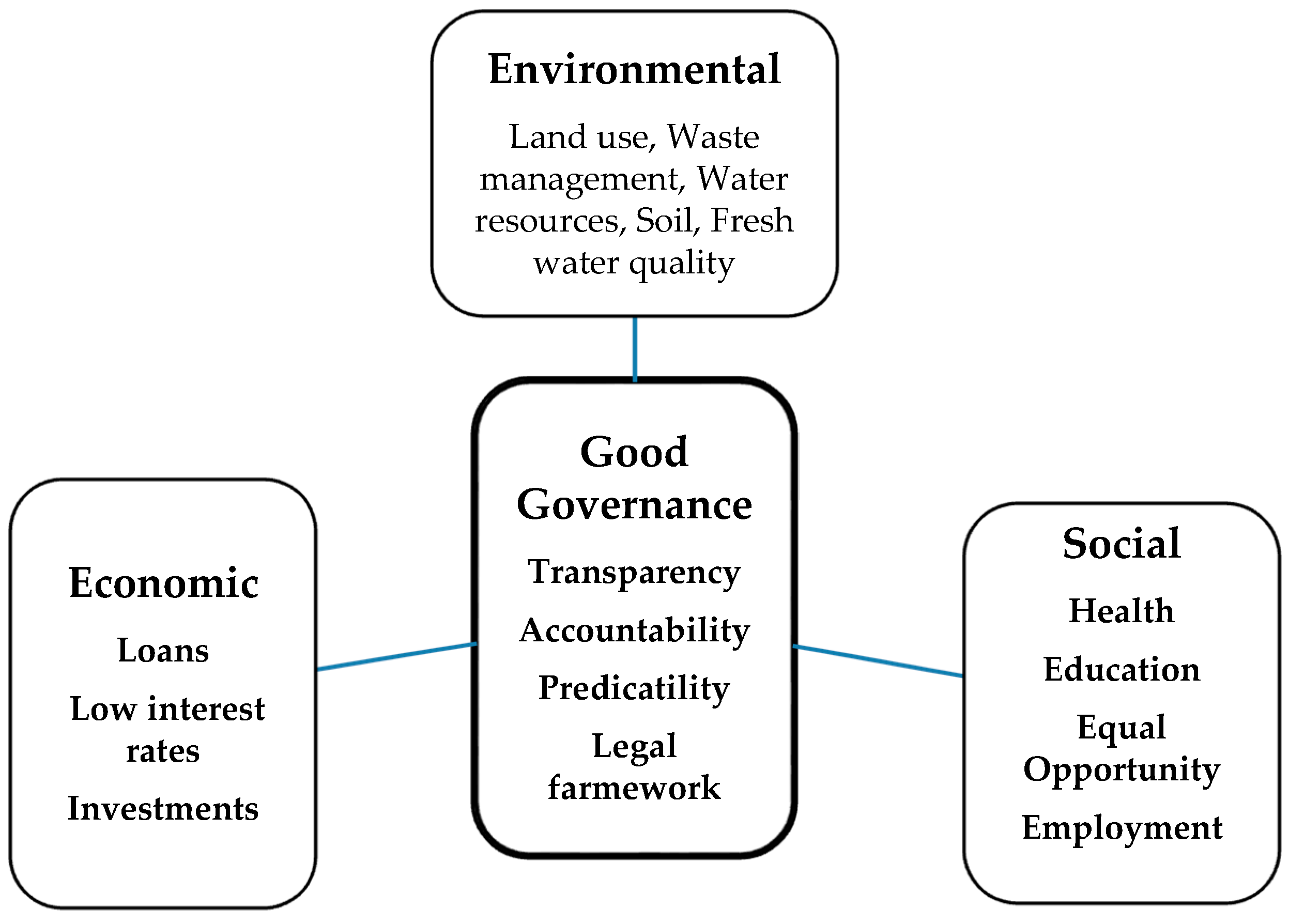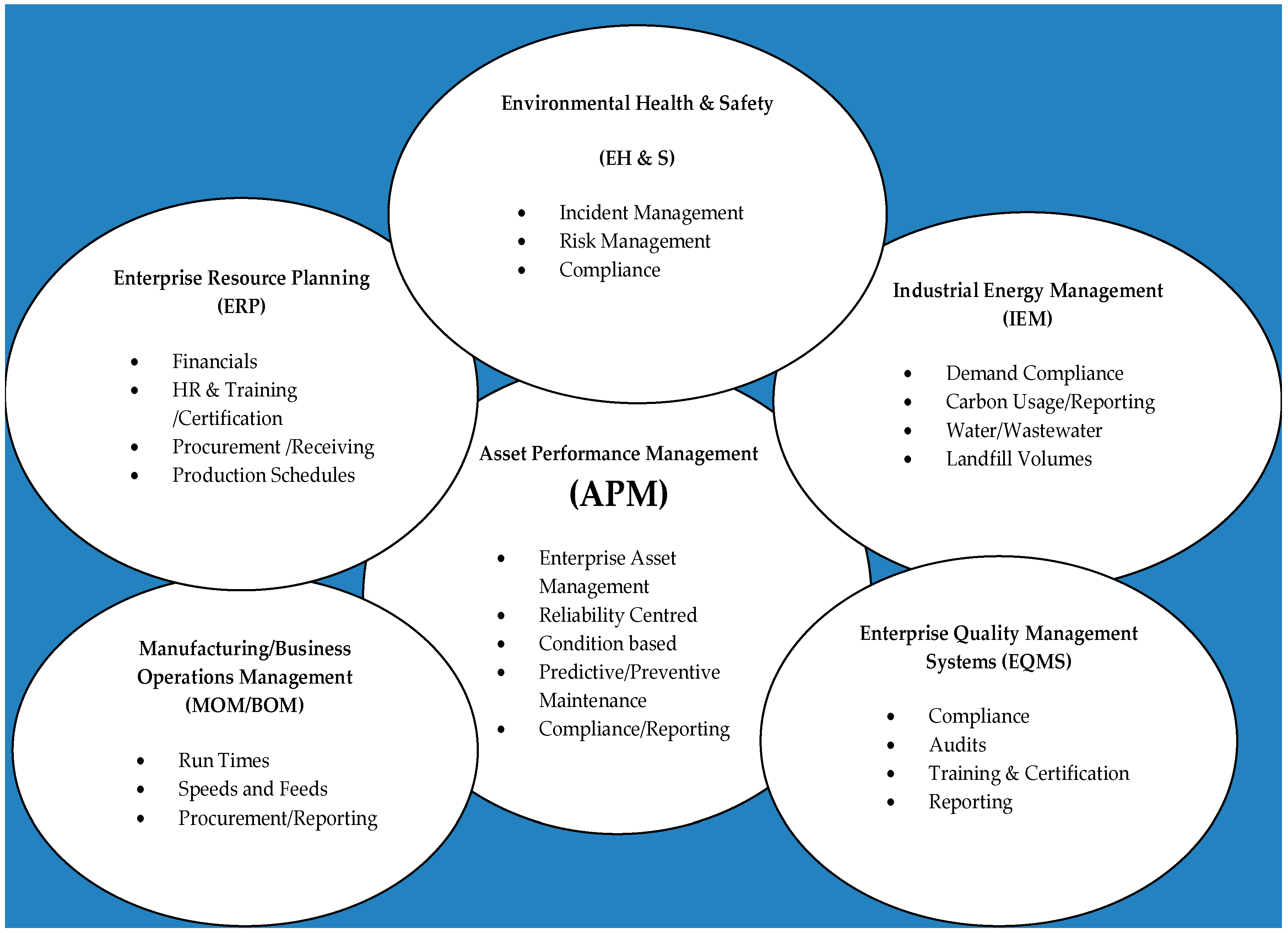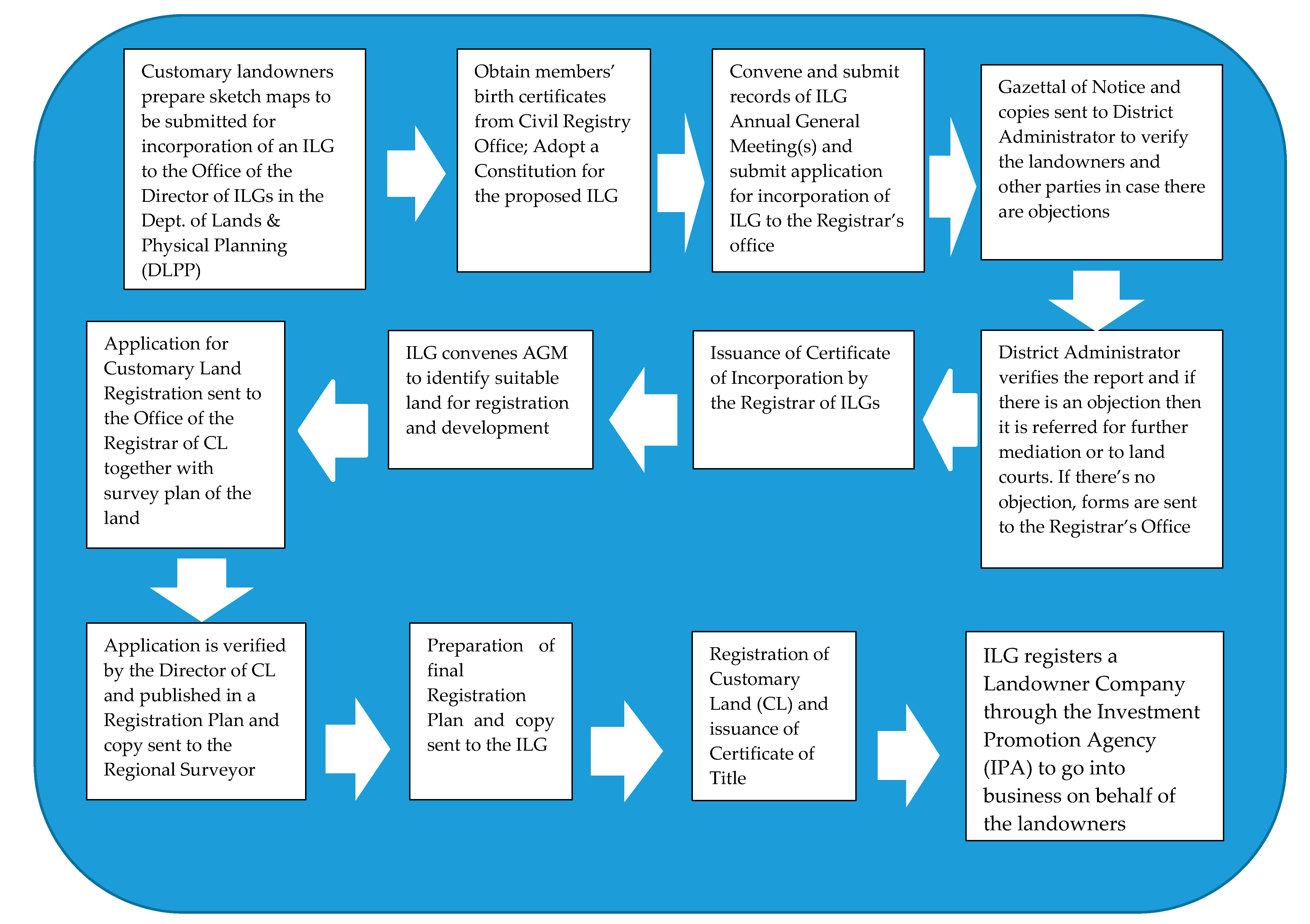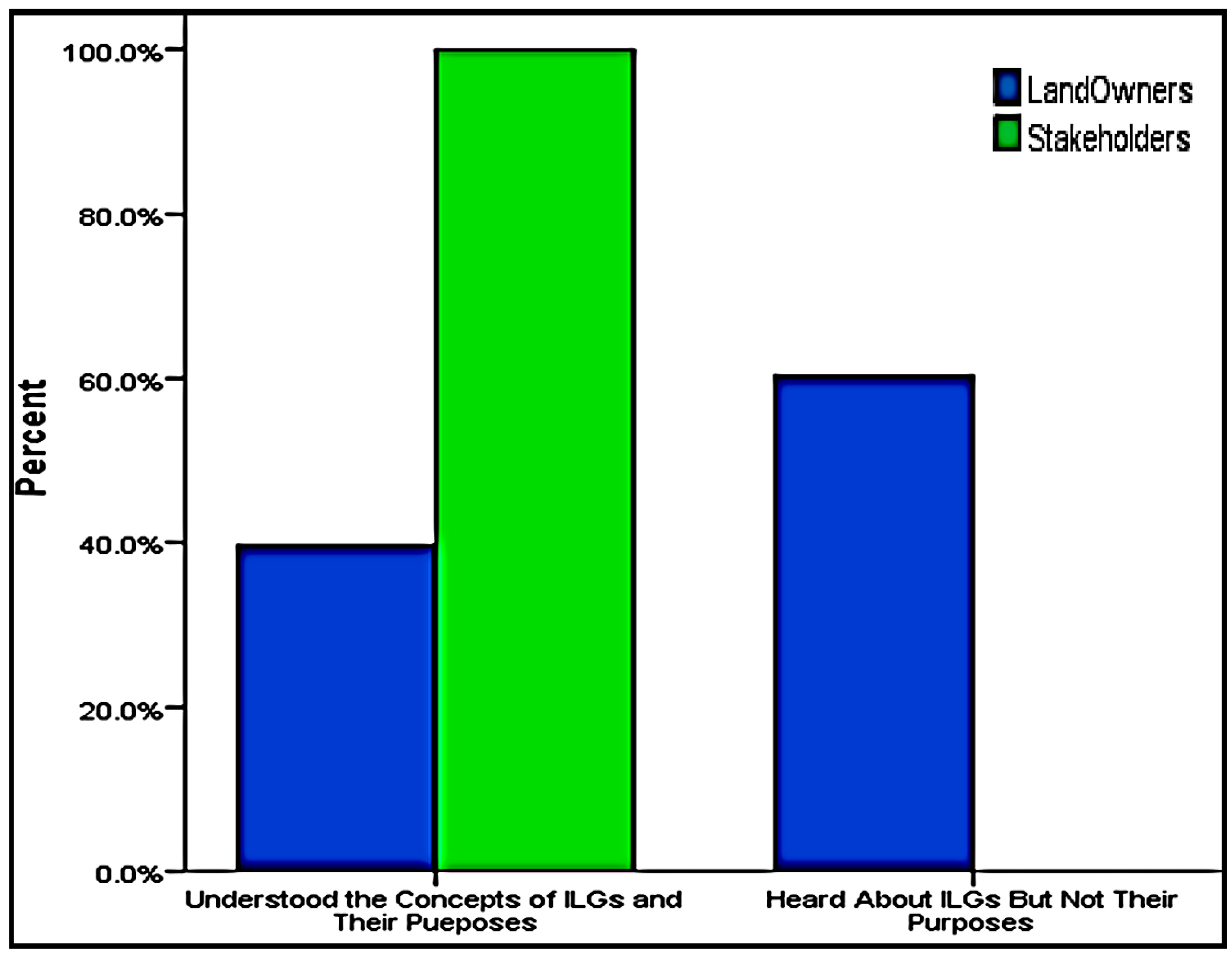Sustainability of Land Groups in Papua New Guinea
Abstract
:1. Introduction
2. Nature of the Problem, Research Questions and Contributions to Knowledge
- (i)
- What are the indicators of sustainability that can be applied in assessing the performance of ILGs in PNG?
- (ii)
- Are the ILGs in PNG sustainable?
3. Conceptual Framework
3.1. Concept of “Sustainability”
3.2. Operationalisation of Four Dimensions of Sustainability
- (i)
- Good governance
- (ii)
- Economic sustainability
- (iii)
- Environmental sustainability
- (iv)
- Social sustainability
4. Literature Review
4.1. Sustainability Indicators and Sustainability Reporting
4.2. Theories of Real Property Rights
4.3. The Defining Issues Facing ILGs in PNG
5. Research Method
- (i)
- Good governance: Better land policies, Corruption Level, and Legal framework for ILGs
- (ii)
- Economic sustainability of ILGs: Profit-making, Cost saving measures and Benefit sharing
- (iii)
- Social sustainability of ILGs: Education/training opportunities, Illegal settlements, and Equal participation by men and women
- (iv)
- Environmental sustainability of ILGs: Land Use, Clean (portable) water
- (v)
- Good governance: Better land policies, Transparency, Accountability
- (vi)
- Economic sustainability of ILGs: Profit-making ventures, Interest rates, Cost savings, Loans
- (vii)
- Social sustainability of ILGs: Education/training facilities, Gender equality, Equal
- (viii)
- participation by men and women, Respect for Melanesian culture
- (ix)
- Environmental sustainability of ILGs: Land resources, Waste management, Environmental planning
5.1. Customary Landowners
5.2. Stakeholders
5.3. The Study Area
6. Findings and Discussion
6.1. Database for ILG Sustainability and Legality
6.2. Research Question 1: What Are the Indicators of Sustainability That Can Be Used to Assess ILGs in PNG?
6.3. Research Question 2: Are the ILGs in PNG Sustainable?
7. Conclusions
- (i)
- There is not enough publicity being given by the PNG government and other stakeholders concerning the purposes of ILGs and the benefits that landowners and the entire communities stand to gain from the sustainability of these legal entities. More than half of the landowners interviewed indicated that they have heard about the concept of ILGs in the country, but they have no knowledge about their purposes or functions. This lack of awareness has been accentuated by the fact that many ILG landowners are illiterates.
- (ii)
- There is an increasing concern that corruption is endemic in the Department of Lands, an indictment that has also been supported by the Minister of Lands who described the department as the most corrupt public service department in PNG [56]. This is the department charged with administering the registration of customary lands and the ILGs in the country. Corruption is akin to a cancerous disease that has rendered many ILGs unsustainable, and the government must derive innovative strategies to stamp out all forms of corruption in the department.
- (iii)
- In line with the proposal of the Minister of Lands and Physical Planning [56] to repeal the section of the Land Act 1996 that allows the Minister to lease customary land for the purpose of granting a special agricultural and business lease (SABL), we recommend that Section 11 and other relevant sections of the Act focusing on SABLs be reviewed or repealed. If not reviewed or cancelled, the SABLs have the potential to create a large number of landless people in PNG who (if they cannot grow subsistence food on their customary land) will have no other option but to move into towns and cities to survive, thereby aggravating the country’s rural-urban migration crisis.
- (iv)
- Out of the 116 landowners interviewed, only 10.3 % indicated that ILGs are legally recognized entities that are protecting landowner rights in the country, while 89.7% of the landowners claimed that the legal framework is flawed and is not adequately protecting landowner rights (Table 6). In contrast, 61.5% of the stakeholders claimed that the legal framework for ILGs is adequately protecting landowner rights, while only 38.5% indicated that the legal framework for ILGs in the country is flawed. These findings imply that the ILGs are not sustainable legal entities. The ILG legal framework requires an urgent overhaul in order to pave way for ILG landowners’ freedom from land grabs and other forms of extortion.
- (v)
- A total of 25 sustainability indicators were applied in assessing ILG sustainability in Papua New Guinea. This number comprises a set of 12 indicators used in assessing the landowners’ perceptions of ILG sustainability (Table 4), while another set of 13 indicators was employed in assessing the stakeholders’ perceptions (Table 5). However, only one indicator out of the 25 indicators used—i.e., land resources (53.7%), an environmental indicator in the stakeholders’ category—was positively rated as being a true reflection of ILG sustainability. Effectively, all the other indicators used fell within a range of 15%–47.4% levels of disapproval by both the landowners and stakeholders. We recommend that further research in the area of ILG sustainability be encouraged and financed by the various arms of government in PNG, the National Research Institute (NRI), the National Agricultural and Forestry Research Institutes, the private sector, and the universities, amongst others. Such research endeavors targeting the ILGs would need to be aligned with the goal and objectives of PNG Vision 2050 for purposes of cost-effective land policy formulation and implementation.
Acknowledgments
Author Contributions
Conflicts of Interest
Abbreviations
| ALT | Alienated Land Tenure |
| ANZ | Australia New Zealand |
| BSP | Bank South Pacific |
| CBD | Central Business District |
| CL | Customary Land |
| CLT | Customary Land Tenure |
| LTS | Land Tenure System |
| ILGs | Incorporated Land Groups |
| LCPPA | Lae City Physical Planning Area |
| MIC | Malahang Industrial Centre |
| MLSC | Melanesian Land Studies Centre |
| PNG | Papua New Guinea |
| Unitech | University of Technology |
| VCLR | Voluntary Customary Land Registration |
| CSR | Corporate Social Responsibility |
| EHS | Environmental Health and Safety |
| APM | Asset Performance Management |
| LRA | Land Registration Act |
| FOLA | Focus on Land in Africa |
| GRI | Global Reporting Initiative |
References
- Power, A.P. Land Mobilisation Programme in Papua New Guinea: Land Group Incorporation: Village Guide and Legal Guide. 2001. Available online: http://www.pngbuai.com/300socialsciences/management/land-development/indigenouslandgroupsregistration1.html (accessed on 25 May 2016).
- Dixon, K. Working with mixed commons/anticommons property: Mobilizing customary land in Papua New Guinea the Melanesian way. Harv. Environ. Law Rev. 2007, 31, 219. [Google Scholar]
- Colonialism and the Expansion of Empires: Revealing Histories. Available online: http://revealinghistories.org.uk/colonialism-and-the-expansion-of-empires.html (accessed on 21 May 2015).
- Amankwah, H.A.; Mugambwa, J.T.; Muroa, G. Land Law in Papua New Guinea; University of Papua New Guinea Press: Port Moresby, Papua New Guinea, 2009. [Google Scholar]
- Oliver, N.; Fingleton, J. Settling customary land disputes in Papua New Guinea. In Making Land Work, Volume Two: Case Studies on Customary Land and Development in the Pacific; AusAID: Canberra, Australia, 2008; pp. 223–240. [Google Scholar]
- Armitage, L. Indigenous Property Rights. Custom and Commerce at the Interface, Brisbane, Queensland University of Technology. 2000. Available online: http://scholar.google.com/scholar?biw=320&h=303&um=1ie=UTF8lr&cites93615458325954 (accessed on 20 May 2014).
- Lakau, A. State Acquisition of Customary Land for Public Purposes in Papua New Guinea; Department of Surveying and Land Studies, Papua New Guinea University of Technology: Lae, Papua New Guinea, 1991. [Google Scholar]
- Martin, K. Land, customary and non-customary in East New Britain. In Customary Land Tenure and Registration in Australia and Papua New Guinea: Anthropological Perspectives; Weine, J.F., Glaskin, K., Eds.; ANU E Press: Canberra, Australia, 2007; pp. 39–56. [Google Scholar]
- Fingleton, J.S. The East Sepik land legislation. In Customary Land Tenure, Registration and Decentralisation in Papua New Guinea; IASER Monograph No. 29; Larmour, P., Ed.; National Research Institute: Boroko, Papua New Guinea, 1991; Available online: http://press.anu.edu.au/apem/customary/mobile_devices/ch07s02.html (accessed on 15 May 2014).
- Filer, C. The double movement of immovable property rights in Papua New Guinea. J. Pac. Hist. 2014, 49, 76–94. [Google Scholar] [CrossRef]
- Kwapena, F. Empowering Customary Landowners to Give Value to Their Land; NRI Commentary: Port Moresby, Papua New Guinea, 2014. [Google Scholar]
- Kalinoe, L.K. Incorporated Land Groups in Papua New Guinea. 2003. Available online: http://www.google.com.pg/search?q=ilg+ing&biw=320&bih=508&prmd=1.5#q=ilg+in+png (accessed on 2 April 2014).
- Yala, C. The Genesis of the Papua New Guinea Land Reform Programme, Port Moresby, PNG, The National Research Institute. 2010. Available online: http://www.nri.org.pg/index.php/13-researchers-profile/139-charles-yala-profile (accessed on 9 May 2014).
- Fingleton, J.S. Legal Recognition of Indigenous Groups. 1998. Available online: http://press.anu.edu.au/apem/customary/mobile_devices/ch07s02.html (accessed on 15 May 2014).
- Ogle, L.; Tararia, A. Incorporated Land Groups and the Registration of Customary Land-Recent Developments in PNG. 2007. Available online: http://scholar.google.com/scholar?um=1&ie-UTF-8&lr&cites=10774025897395858495 (accessed on 14 August 2015).
- Goldman, L. PNG Gas Project Social Impact Assessment; Exxon Mobil: Brisbane, Australia, 2005; Available online: http://press.anu.edu.au/apem/customary/pdf/ch06.pdf (accessed on 14 December, 2015).
- Young, M. Logging or Conservation on Woodlark (Muyuw) Island, Department of Anthropology, Research School of Pacific Studies, Australian National University. 1990. Available online: http://www.ulg.ac.be>PARROTS>YOUNG (accessed on 14 July 2015).
- Filer, C. New Land Grab in Papua New Guinea. Pac. Stud. 2011, 34, 269–294. [Google Scholar]
- Kocmanova, A.; Simberova, I. Determination of environmental, social and corporate governance indicators: Framework in the measurement of sustainable performance. J. Bus. Econ. Manag. 2014, 15, 1017–1033. [Google Scholar] [CrossRef]
- Gilberthorpe, E. Fasu solidarity: A case study of kin networks, land tenure, and oil extraction in Kutubu, Papua New Guinea. Am. Anthropol. 2007, 109, 101–112. [Google Scholar] [CrossRef]
- Moore, E. The Administration of Special Purpose Agricultural and Business Leases: Customary Land and the Lease-Lease-Back System, 2011; Discussion Paper 118; PNG National Research Institute: Boroko, Papua New Guinea, 2011. [Google Scholar]
- Dwyer, P.D.; Minnegal, M. Where all the rivers flow west: Maps, abstraction and change in the Papua New Guinea lowlands. Aust. J. Anthropol. 2014, 25, 37–53. [Google Scholar] [CrossRef]
- Minnegal, M.; Lefort, S.; Dwyer, P.D. Reshaping the Social: A Comparison of Fasu and Kubo-Febi Approaches to Incorporating Land Groups. Asia Pac. J. Anthropol. 2015, 16, 496–513. [Google Scholar] [CrossRef]
- Weiner, J.F. The incorporated what group: Ethnographic, economic and ideological perspectives on customary land ownership in contemporary Papua New Guinea? Anthropol. Forum 2013, 23, 94–106. [Google Scholar] [CrossRef]
- Weiner, J.F.; Glaskin, K. Customary Land Tenure and Registration in Australia and Papua New Guinea; ANU E Press: Canberra, Australia, 2013. [Google Scholar]
- Weiner, J.F. The Foi Incorporated Land Group: Group definition and collective action in the Kutubu oil project area. In Customary Land Tenure and Registration in Australia and Papua New Guinea: Anthropological Perspectives; Weine, J.F., Glaskin, K., Eds.; ANU E Press: Canberra, Australia, 2007; pp. 117–134. [Google Scholar]
- Bell, J.A. Documenting discontent: Struggles for recognition in the Purari Delta of Papua New Guinea. Aust. J. Anthropol. 2009, 20, 28–47. [Google Scholar] [CrossRef]
- Filer, C. Local custom and the art of land group boundary maintenance in Papua New Guinea. In Customary Land Tenure and Registration in Australia and Papua New Guinea: Anthropological Perspectives; Weine, J.F., Glaskin, K., Eds.; ANU E Press: Canberra, Australia, 2007; pp. 135–174. [Google Scholar]
- Green Peace Australia Pacific. Millions of Hectares of Customary Land Stolen. 2012. Available online: http://www.actnowpng.org (accessed on 15 May 2015).
- Sustainability Reporting. Available online: http://www.Insresearch.com/research-library/metrics-that-matter (accessed on 22 February 2016).
- Ceres, Sustainability Report, 2002–2003. Available online: http://www.ceres.org/resources/reports/ceres-annual-report-2003 (accessed on 22 February 2016).
- Sustainability. Available online: http://www.environmentalleader.com/category/sustainability/#ixzz40CVURHa8 (accessed on 4 February 2016).
- Rodriguez, S.I.; Roman, M.S.; Sturhahn, S.C.; Terry, E.H. Sustainability Assessment and Reporting for the University of Michigan’s Ann Arbor Campus; Report No. CSS02-04; Centre for Sustainable Systems, University of Michigan: Ann Arbor, MI, USA, 2002. [Google Scholar]
- The Global 100. An Index of the Global 100 Most Sustainable Corporations in the World. Available online: http://www.corporateknights.com/reports/global-100/ (accessed on 14 February 2016).
- Elkington, J. Cannibals with Forks: Triple Bottom Line of 21st Century Business; New Society Publishers: Stoney Creek, CT, USA, 1997. [Google Scholar]
- Weber, M. The Role of Good Governance in Sustainable Development. 2015. Available online: http://www.wri.org/blog/2015/02/qa-mark-robinson-role-good-governance-sustainable-development (accessed on 20 July 2015).
- Drexhage, J.; Murphy, D. Sustainable Development: From Brundtland to Rio 2012; International Institute for Sustainable Development (IISD): New York, NY, USA, 2010. [Google Scholar]
- Petrosyan, A. A model for incorporated measurement of sustainable development comprising remote sensing data and using the concept of biodiversity. J. Sustain. Dev. 2010, 3, 9–26. [Google Scholar] [CrossRef]
- World Bank. Governance and Development; The World Bank: Washington, DC, USA, 1999. [Google Scholar]
- Manasan, R.G.; Gonzalez, E.T.; GaffudR, B. Towards Better Government: Developing Indicators of Good Governance for Local Government; NEDA and UNDP: Pasig City, Philippines, 1999. [Google Scholar]
- Clear Answers for Common Questions: What is Sustainability? Available online: http://www.wisegeek.org/what-is-economic-sustainability.htm (accessed on 24 February 2016).
- FAO/UNEP. Development of the Land Cover Classification System (LCCS). 1999. Available online: http://www.fao.org/docrep/008/y7220e/y7220e06.htm (accessed on 5 May 2015).
- What Is Sustainability and Why Is It Important? Available online: http://www.environmentalscience.org/sustainability (accessed on 25 February 2016).
- World Bank: A Holistic Approach to Environmental Sustainability. 1999. Available online: http://www.worldbank.org/mdgs/environment.html (accessed on 20 February 2016).
- World Bank Group. Ensure Environmental Sustainability by 2015. 2010. Available online: http://www.worldbank.org/mdgs/environment.html (accessed on 20 February 2016).
- Social Sustainability. Available online: http://www2.econ.iastate.edu/classes/tsc220/hallam/HallamLectures/SocialSustainability.pdf (accessed on 24 February 2016).
- Henry, K. CDP Reveals 2015 Climate A List, Environmental Leader. 2015. Available online: http://www.environmentalleader.com/2015 (accessed on 14 February 2016).
- Asset Performance Management. Available online: http://www.lnsresearch.com/research-library/asset-performance-management (accessed on 15 February 2016).
- Wangi, T. Solid Waste Management in Papua New Guinea. 2013. Available online: http://devpolicy.org/solid-waste-management-in-papua-new-guinea-20130812/#comment-523579 (accessed on 15 February 2016).
- Leavoy, P. Sustainability Reporting: The What and Why? 2016. Available online: http://www.environmentalleader.com/2014/09/15/sustainability-reporting-the-what-and-why/ (accessed on 22 March 2016).
- Ostrom, L. How Types of Goods and Property Rights Jointly Affect Collective Action. 2003. Available online: http://ostromworkshop.indiana.edu/reprints/R03_14.pdf (accessed on 24 February 2016).
- Federal Geodetic Control Committee (FGCC). Geometric Geodetic Accuracy Standards and Specifications for Using GPS Relative Positioning Techniques. 1989. Available online: http://www.ngs.noaa.gov/PUBS_LIB/GeomGeod.pdf (accessed on 22 February 2016). [Google Scholar]
- Cuervo Property Advisory. Land and “Ownership of Wide Distribution” 2013. Available online: https://cuervopropertyadvisory.wordpress.com/2013/11/17/land-and-ownership-of-wide-distribution/ (accessed on 28February 2016).
- Filer, C. Why green grabs don’t work in Papua New Guinea. J. Peasant Stud. 2012, 39, 599–617. [Google Scholar] [CrossRef]
- PNG Government Media. PNG Government Hopes SABL Leases to Be Revoked Soon. 2015. Available online: http://www.radionz.co.nz/international/pacific-news/286112/png-govt-hopes-sabl-leases-to-be-revoked-soon (accessed on 8 May 2016).
- Minister of Land’s Indictment of the Department of Lands. Available online: http://lands.gov.pg/Services/Governance/Complaints_Desk.html (accessed on 8 May 2016).
- Koyama, S.K. Reducing agency problems in Incorporated Land Groups. Pac. Econ. Bull. 2004, 19, 20–31. [Google Scholar]
- PNG National Statistical Office. Demographic Indicators for Papua New Guinea. 2015. Available online: http://www.nso.gov.pg/index.php/population-and-social/demographic-indicators (accessed on 24 June 2015). [Google Scholar]
- Morse, S. Greening the United Nations’ human development index? Sustain. Dev. 2003, 11, 183–198. [Google Scholar] [CrossRef]
- Brundtland Report on Sustainable Development. Our Common Future. 1987. Available online: http://www.un-documents.net/our-common-future.pdf (accessed on 15 March 2016).





| Bundles of Rights | Full Owner | Proprietor | Authorized Claimant | Authorized Entrant |
|---|---|---|---|---|
| Access | X | X | X | X |
| Withdrawal | X | X | X | |
| Management | X | X | ||
| Exclusion | X | |||
| Alienation | X |
| Title Owner | Public Use | Government | Third Party |
|---|---|---|---|
| Possession (Right to use and occupy) | Railroad | Collect Property Tax | Possession—Right to use and occupy as tenant |
| Legal Title | Public Works | Enforce Lien | |
| Mortgage | Electric Power Transmission lines | Protect Endangered Species | Freedom to Roam |
| Lease | Air Rights | Protect Water lands | Home Owners Associations |
| Sell | Riparian Water Rights | Zoning | Historic Preservations |
| Subdivide the Property | Mineral Rights | Eminent Domain | Conservation Easement |
| Create a Covenant with the Land | Prohibit Noxious or Nuisance Use | Adverse Possession |
| Sampling Frame | |||||
|---|---|---|---|---|---|
| Sample Population | Population Sample | Target | Percentage | Returned | Percentage |
| Landowners (Household Surveys) | 500 Households | 150 | 30 | 116 | 23.2 |
| Stakeholders (Govt. Depts., Developers and Banks | 20 Offices | 20 | 100 | 13 | 65 |
| Total | 520 | 170 | 32.7 | 129 | 24.8 |
| Landowners’ Perceptions (Percent) | |||||||
|---|---|---|---|---|---|---|---|
| Good Governance | Economic Dimension | Social Dimension | Environmental Dimension | ||||
| Better Land Policies | 26.7 | ProfitAcceptable | 38.8 | Education/Training | 19.8 | Good Land use32.8 Planning | |
| Corruption High | (51.7) | Cost Saving is Good | 16.4 | Cultural Relevance | 47.4 | Clean Water | 37.9 |
| Legal Framework isGood | 21.6 | Equal Benefit Sharing | 44.8 | Equal Participation | 32.8 | Solid Waste29.3 Management | |
| Total | 100% | 100% | 100% | 100% | |||
| Stakeholders’ Perceptions (Percent) | |||||||
|---|---|---|---|---|---|---|---|
| Good Governance | Economic Dimension | Social Dimension | Environmental Dimension | ||||
| Better Land Policies | 40 | Profit Acceptable | 30 | Education/Training | 15 | Land Resources53.7 | |
| Transparency | 15 | Interest Rate Good | 15 | Illegal Settlements | 35 | Environmental Planning | 15.5 |
| Accountability | 20 | Cost Saving Good | 35 | Equal Participation Guaranteed | 18 | Solid Waste Management30.8 | |
| Corruption | 25 | Loans Available | 20 | Cultural Relevance | 32 | ||
| Total | 100% | 100% | 100% | 100% | |||
| Responses | Landowners | Stakeholders | ||
|---|---|---|---|---|
| Frequency | Percent | Frequency | Percent | |
| ILGs are Legal Entities and the Legal Framework is Protecting Landowner Rights | 12 | 10.3 | 8 | 61.5 |
| ILGs are Legal Entities but the Legal Framework is Flawed in Protecting Landowner Rights | 104 | 89.7 | 5 | 38.5 |
| Total | 116 | 100.0 | 13 | 100.0 |
© 2016 by the authors; licensee MDPI, Basel, Switzerland. This article is an open access article distributed under the terms and conditions of the Creative Commons Attribution (CC-BY) license (http://creativecommons.org/licenses/by/4.0/).
Share and Cite
Karigawa, L.; Babarinde, J.A.; Holis, S.S. Sustainability of Land Groups in Papua New Guinea. Land 2016, 5, 14. https://doi.org/10.3390/land5020014
Karigawa L, Babarinde JA, Holis SS. Sustainability of Land Groups in Papua New Guinea. Land. 2016; 5(2):14. https://doi.org/10.3390/land5020014
Chicago/Turabian StyleKarigawa, Lepani, Jacob Adejare Babarinde, and Suman Steven Holis. 2016. "Sustainability of Land Groups in Papua New Guinea" Land 5, no. 2: 14. https://doi.org/10.3390/land5020014





